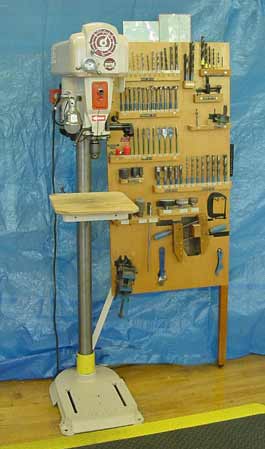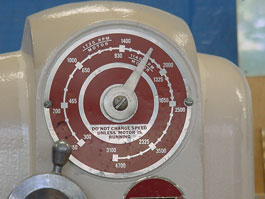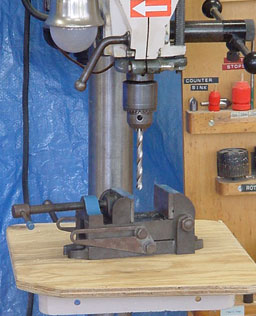|
Home
USING THE 15" DRILL
PRESS
|

|
The Drill press can be used to perform many
functions. Besides its primary function
of drilling or boring holes. You can
also, mortise, route, shape and sand on a Drill
press.
A Drill Press is sized by the
distance from the center of the chuck to the column
doubled, e.g. if the distance from the chuck to
column is 7 1/2" inches, it is a 15 inch
drill press. You can drill a piece of
material 15" in diameter.
|
CONTROLS: The controls on the 15" Delta/Rockwell
drill press in the Materials Processing laboratory consist
of the following;
Off/On Switch, provides power to the
drill.
Elevating Handle allows for adjusting the height of
the table
Angle Lock allows the table to be locked at any angle
necessary for the material being drilled.
Feed Lever allows you to feed the drill bit into the
material.
Depth Stop is used to set a predetermined depth of
the hole being drilled
Spindle this is what actually turns, holding the
chuck and drill bits.
Quill lock this allows you to lower the drill into
the material and lock it in one place. This would be used
mostly during sanding, mortising and routing
operations.
Variable Speed Handle, allows you to set the correct
speed for the material being drilled while the drill is
turning.
Safety Rules: Due to the exposed turning bits used
on the drill press, several hazards exist. The
following safety rules must be followed.
- Always wear safety glasses
- Make sure that all guards are in place and are
correctly adjusted.
- Change belts only when the drill press is stopped and
unplugged.
- Hold the table securely when making table
adjustments.
- Keep fingers far enough away from from the turning
drill to prevent contact with the bit.
- Never use a drill press wearing loose clothing,
jewelry or long hair that could become entangled in the
drill.
- Be sure to have a comfortable stance, never use the
drill press while standing in an awkward position. You
could slip and fall into the drill.
- Avoid distractions, never take your eyes off of the
drill while it is turning, don't look around while
drilling.
- A V-Block must be used when drilling round stock
(dowels, turnings, etc) to prevent slipage.
- Ensure the that the chuck key is removed from the
chuck and table prior to operating the drill.
- Only use proper bits in the drill. Don't use bits
that are designed for hand turned drills or braces.
They could fly out of the drill head.
- Always have someone help support long pieces of
material. Don't try to hold it yourself it could
jam the drill.
- Clamp thin stock to avoid the bit grabbing and
spinning it.
|

|

|
|
This drill has a 1/2 horse power motor that
produces 1140 RPM's. So the lower speed scale is
the one used to adjust the speed of the drill.
|
To prevent injury from flying material, use a
clamp or attachable vice for all metal and small
wooden or plastic pieces.
|
OPERATIONS:
- As you approach the drill press look at it to see if
anything is out of place or missing.
- Check the drill bit being used to ensure it is sharp,
not bent or has any burs on it and that it has the proper
shank. Always use a rounded shank, never a squared
shank.
- When installing the bit in the chuck ensure it is
centered and the shank is deep enough in the jaws, then
tighten using chuck key.
- Remove chuck key from the chuck and drill table
before you start your drilling operation.
- Adjust the table to the correct height and angle
needed before you turn the drill on.
- Align the hole in the center of the table so the bit
will go through the hole and not the table.
- This is a variable speed drill. On this type
of drill the speed must be adjusted while the drill is
turning. Do not attempt to adjust drilling speed while
the drill bit is in the material.
- Use a backer board under your material to prevent
splitting of the wood when drilled.
- Do not clean wood chips or metal shavings from the
table while the drill is turning. Always shut the drill
off, wait until the drill stops, then sweep the table
off.
References:
Hammond, James J., Donnelly, Edward T., Harrod, Walker
F., Rayner, Nonnan A. (1972).
Woodworking Technology. McKnight Publishing Co.
Bloomington, IL.
Feirer, John L. (1988). Cabinet making and Millwork.
Glencoe/Mcgraw-Hill. Peoria, IL.
ITT 252 -Materials Processing
Department of Technology
University of Southern Maine
prepared by Joseph A. Aldoupolis, 9/25/2001
|